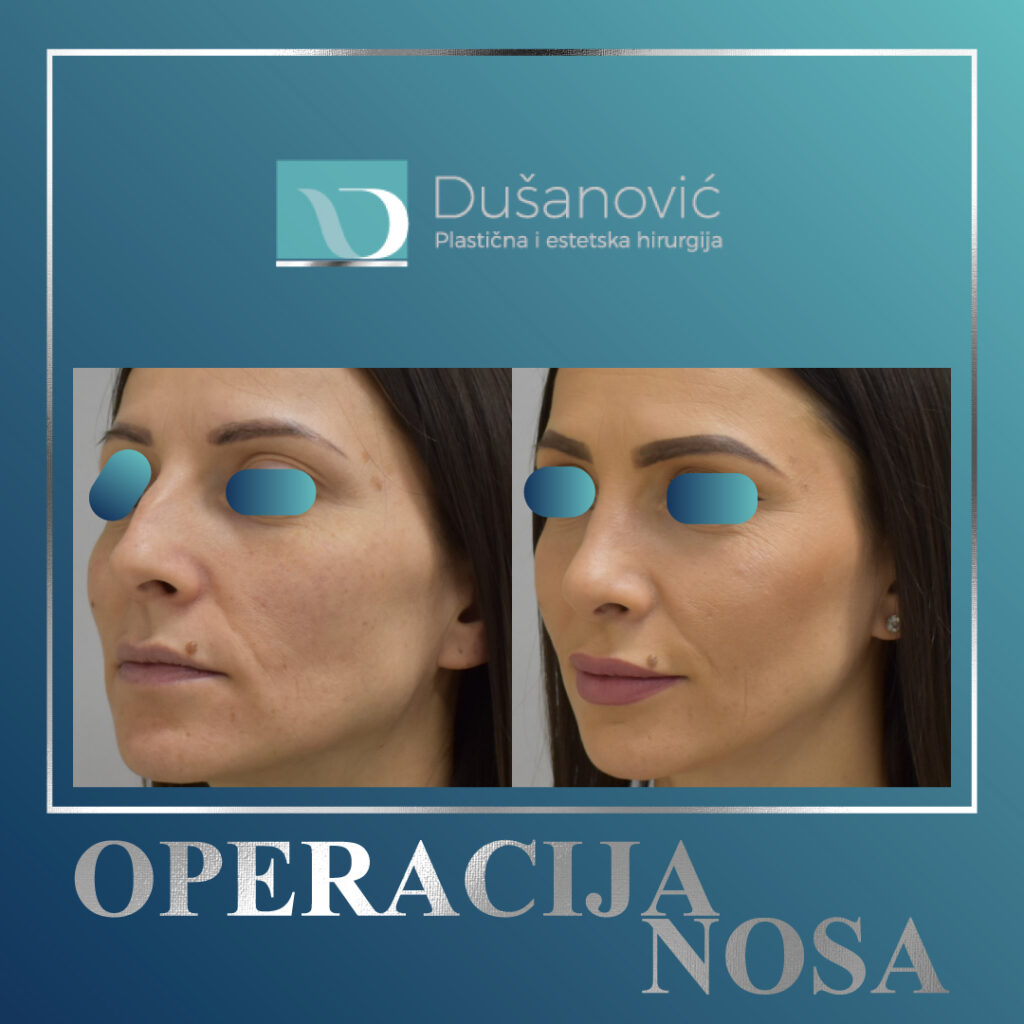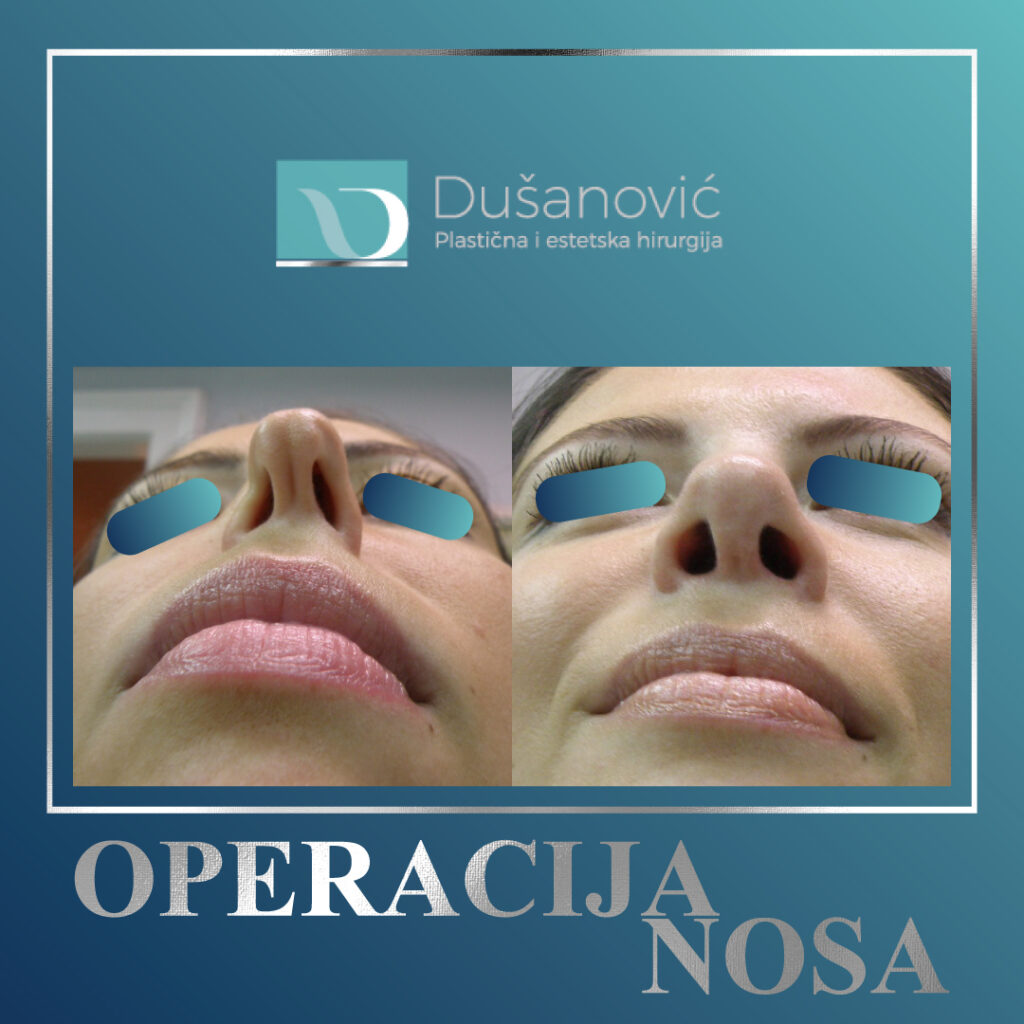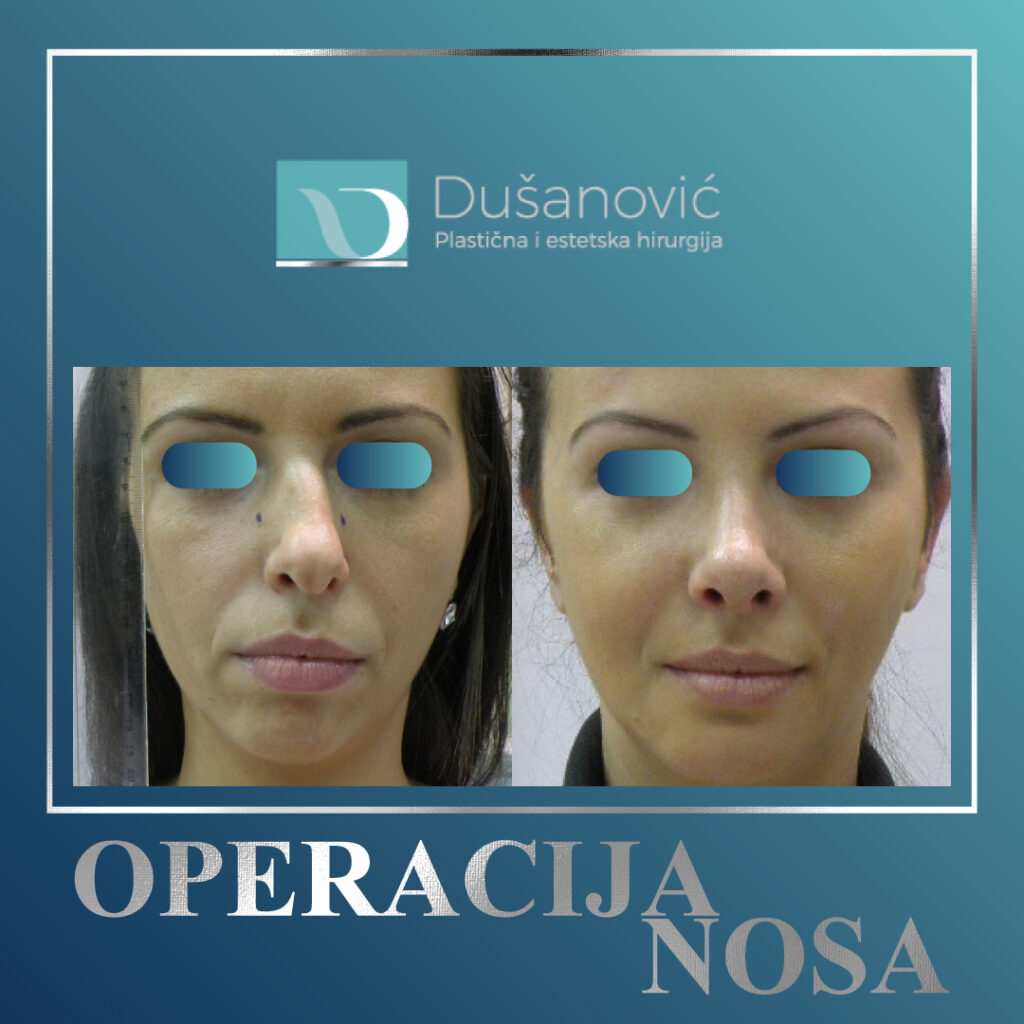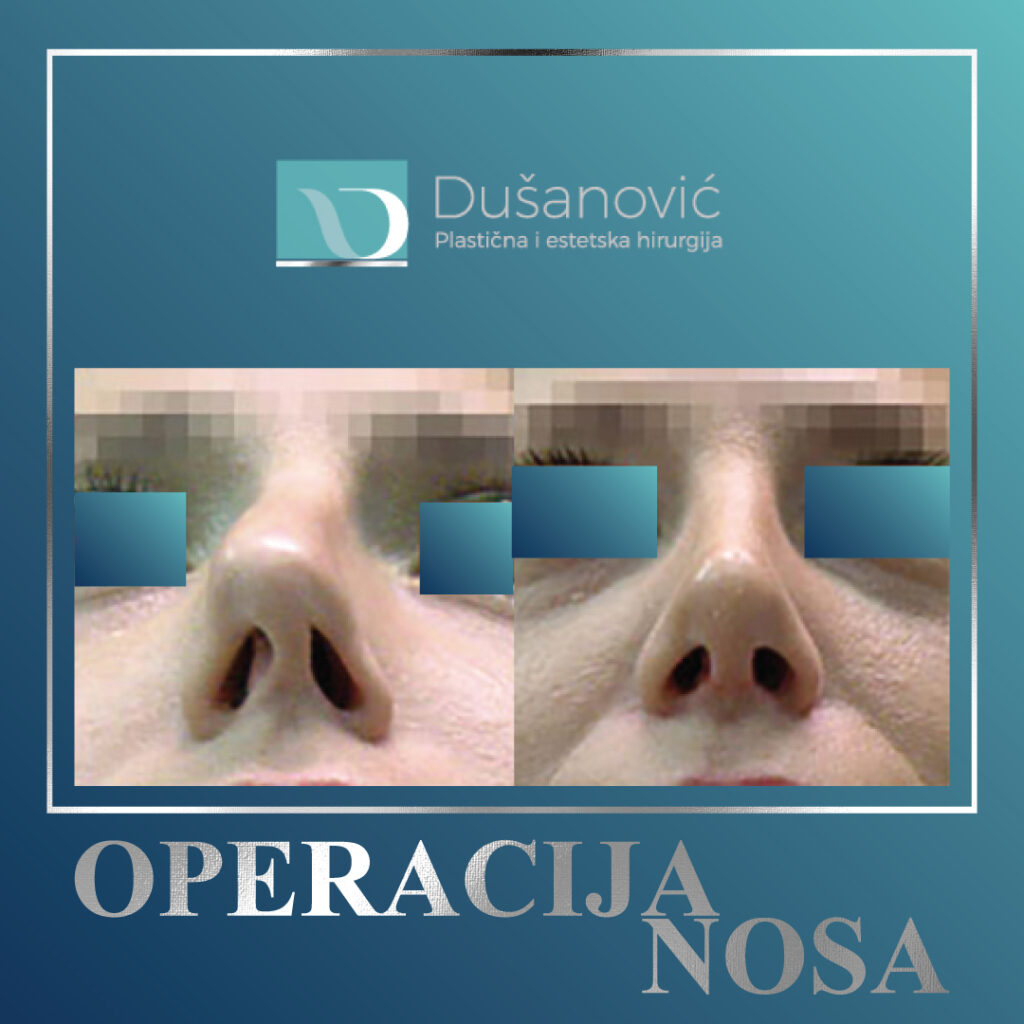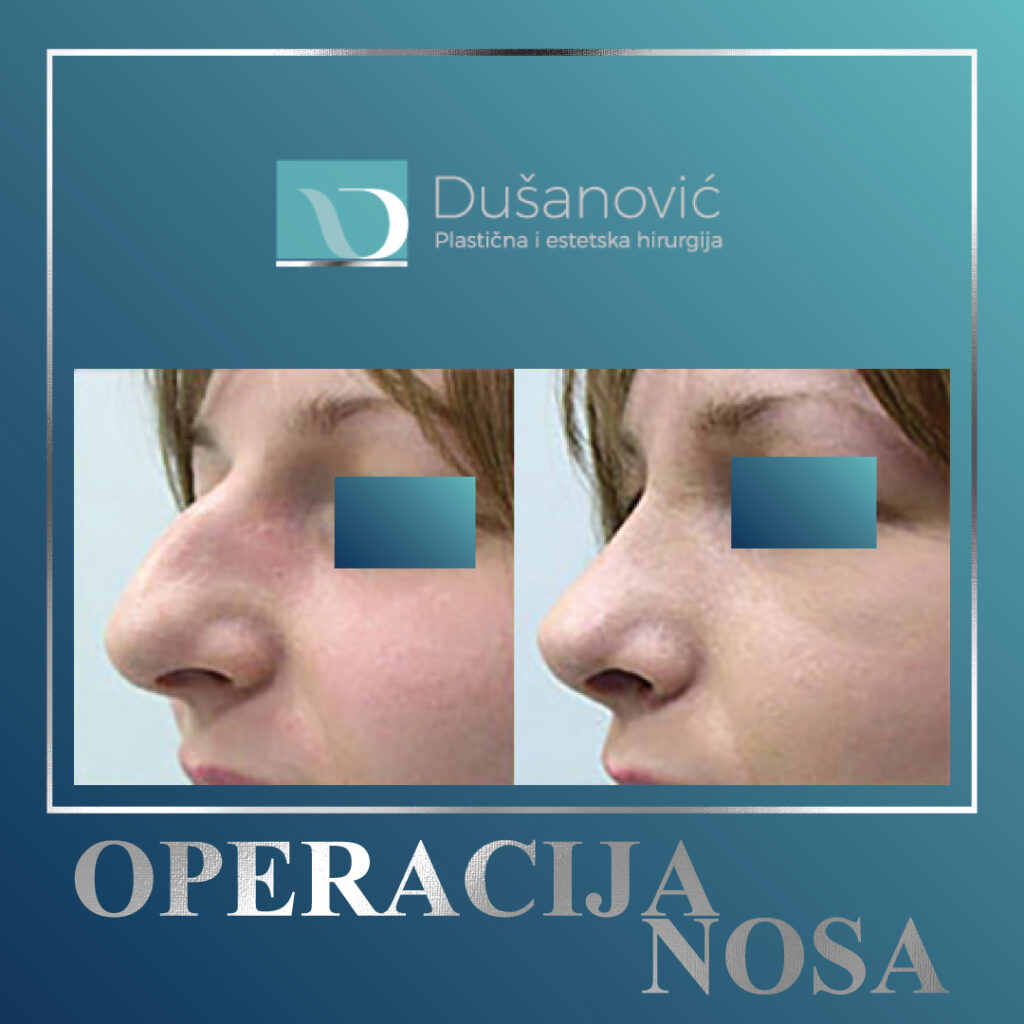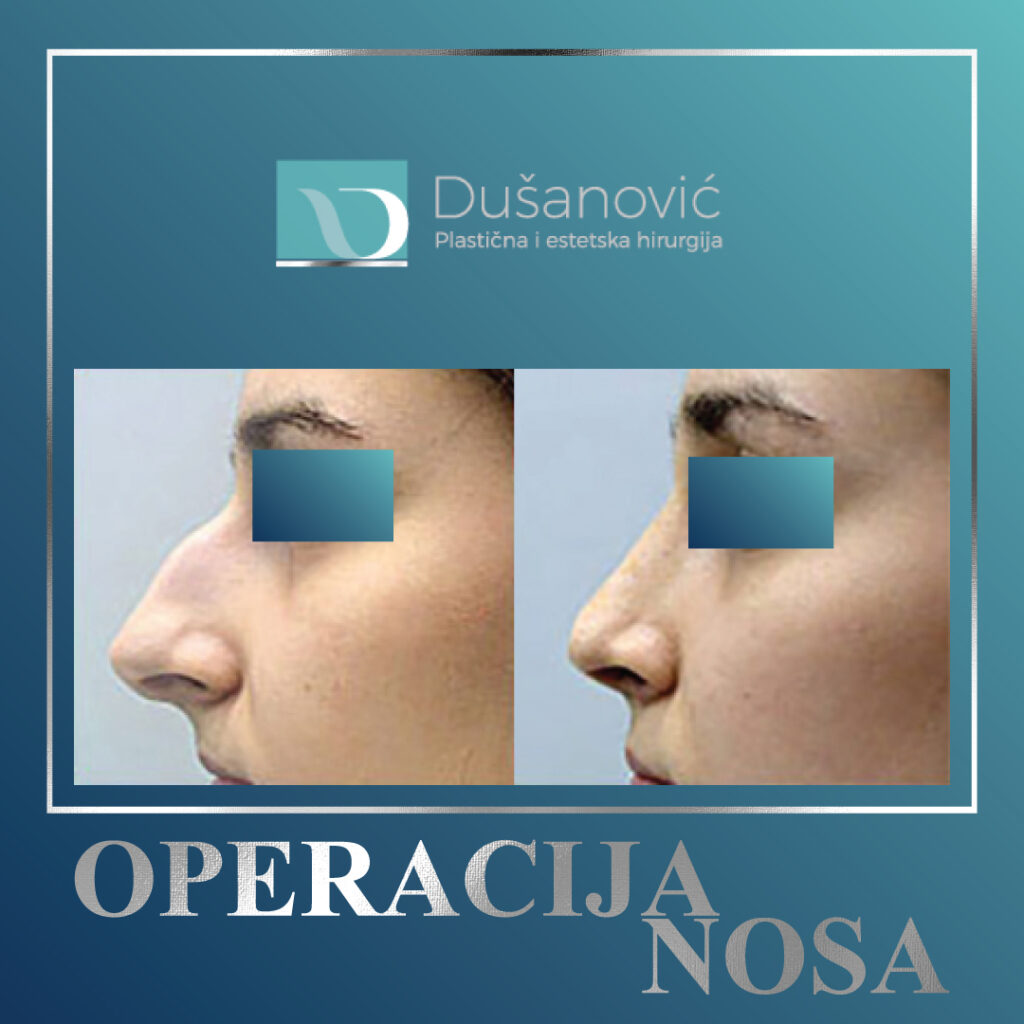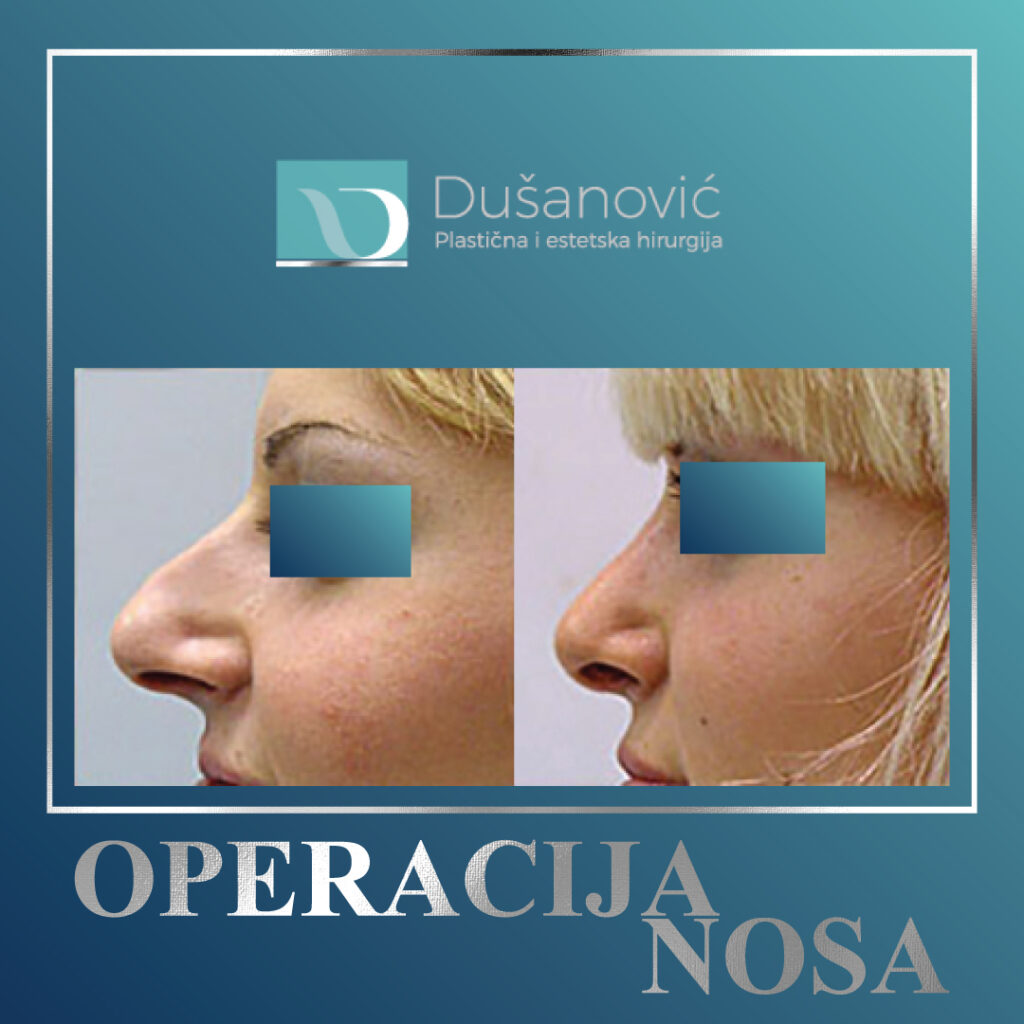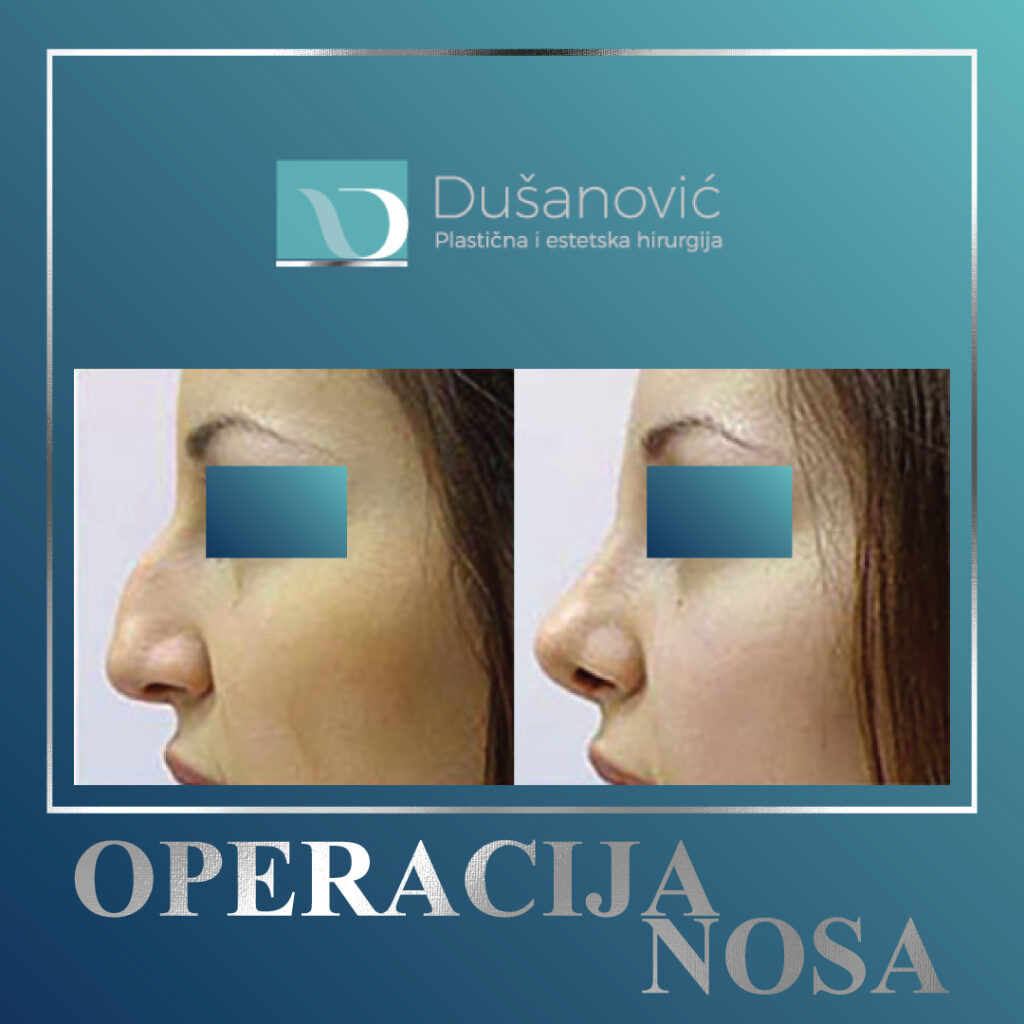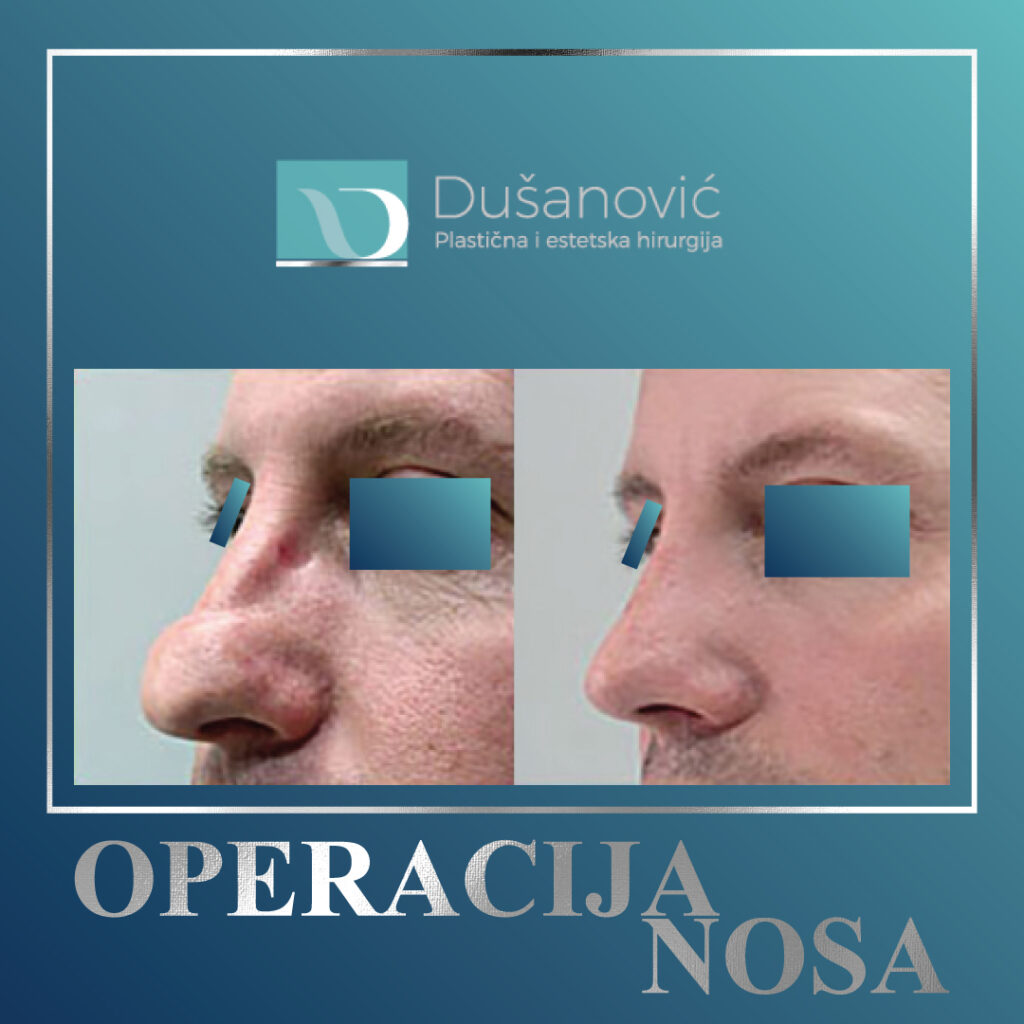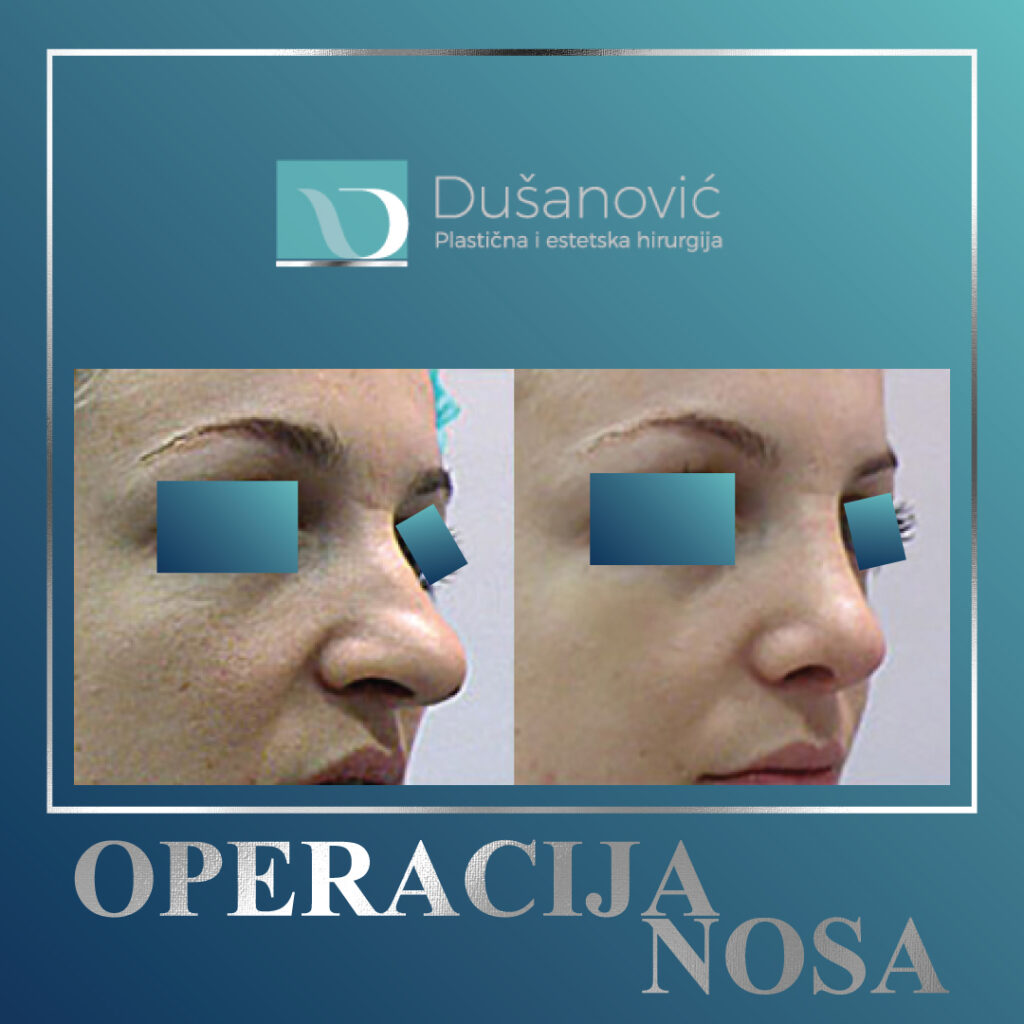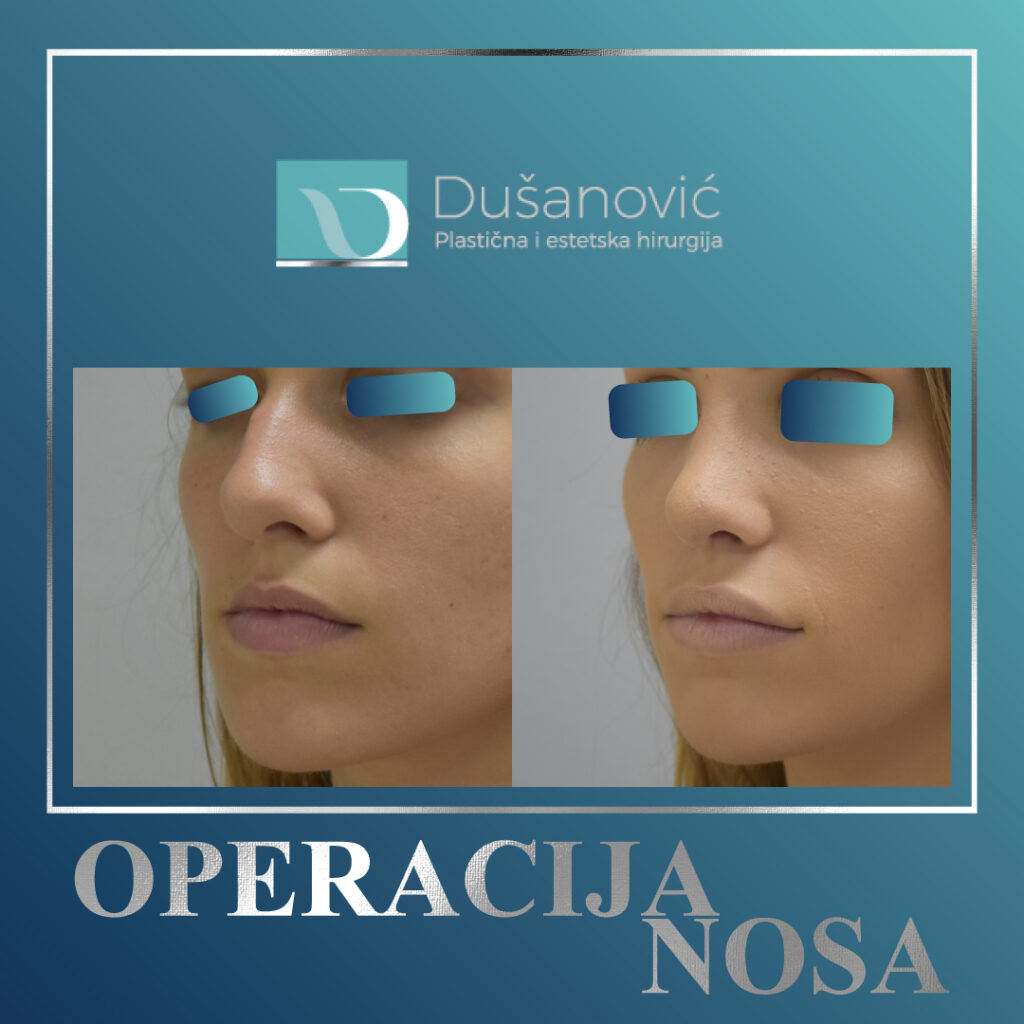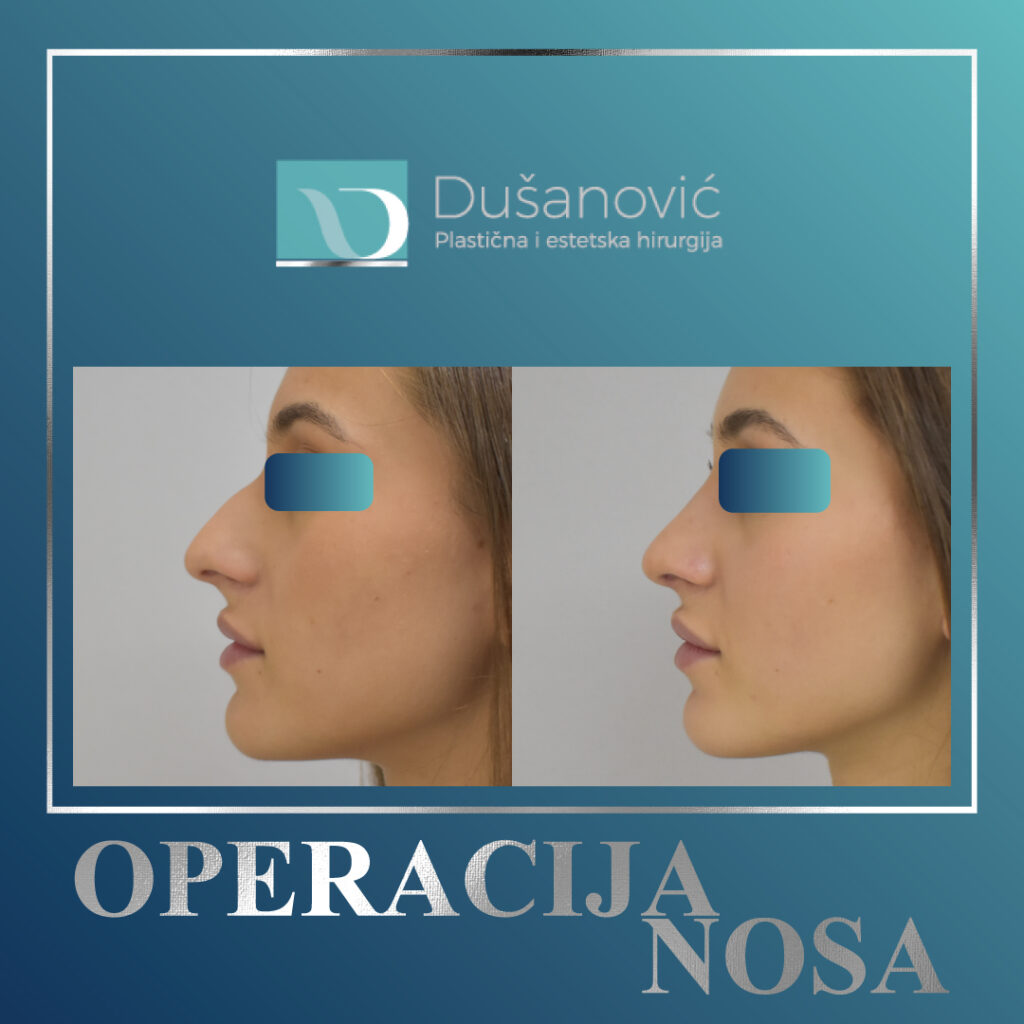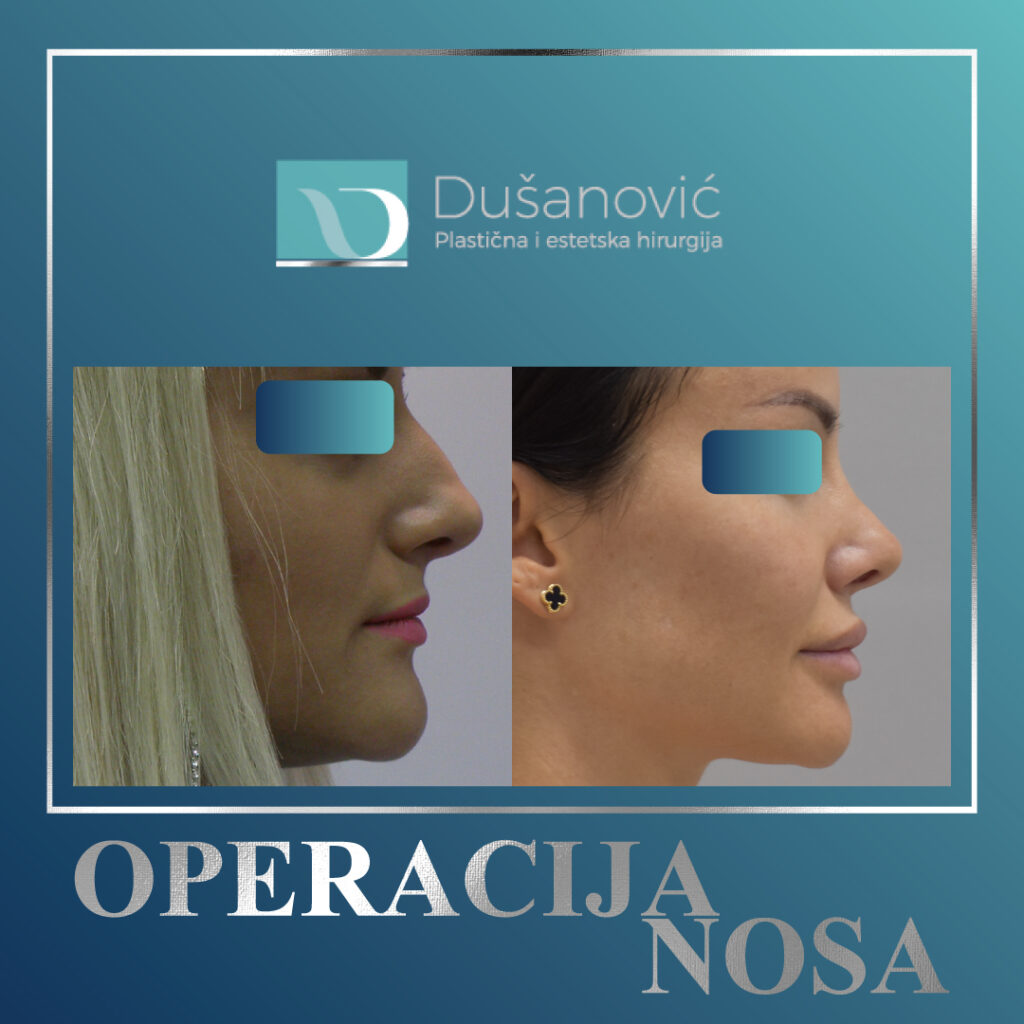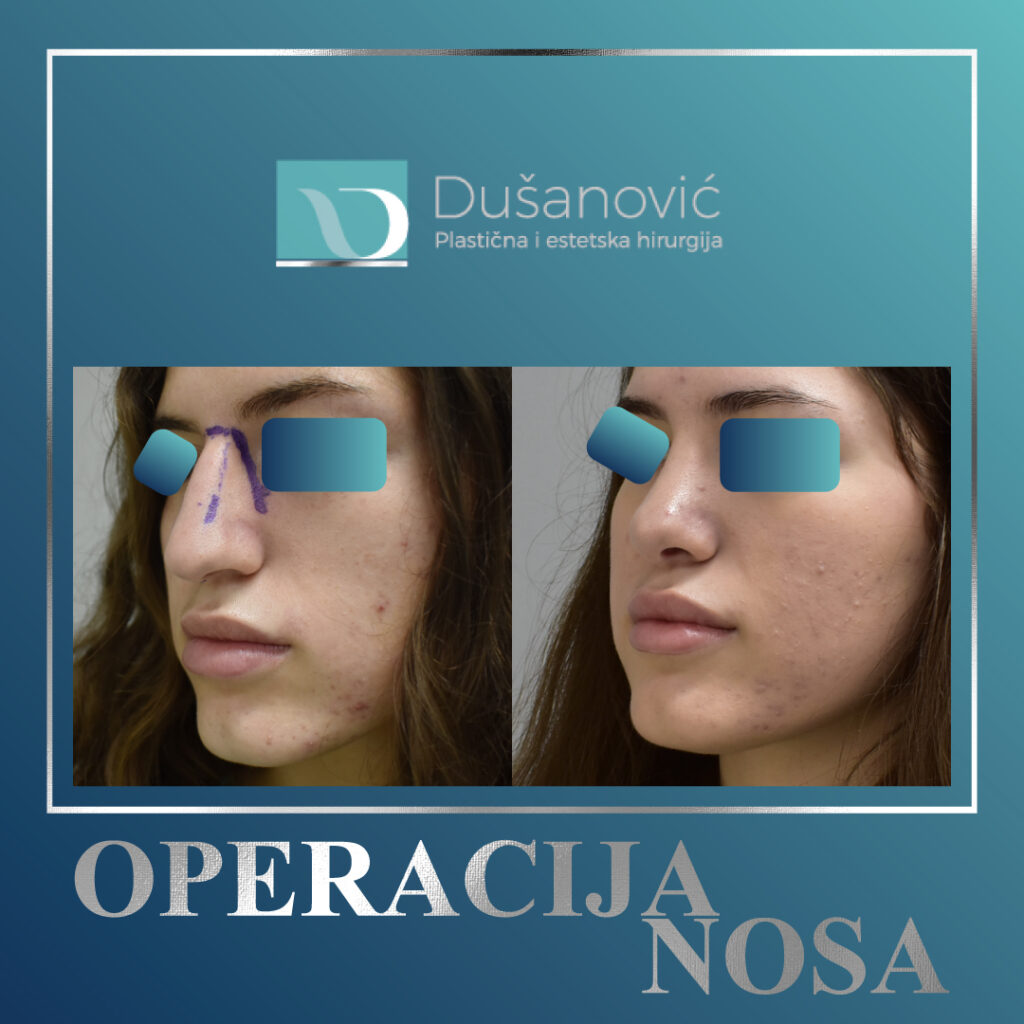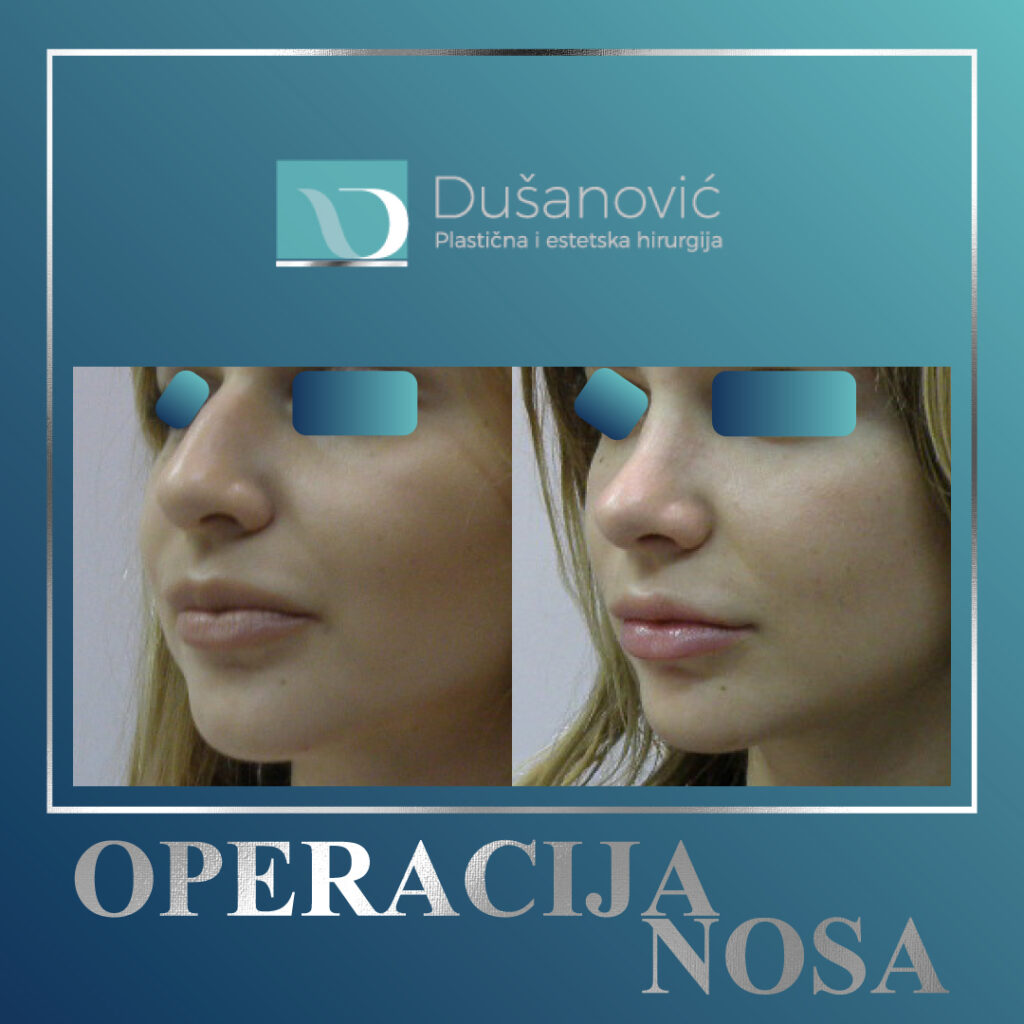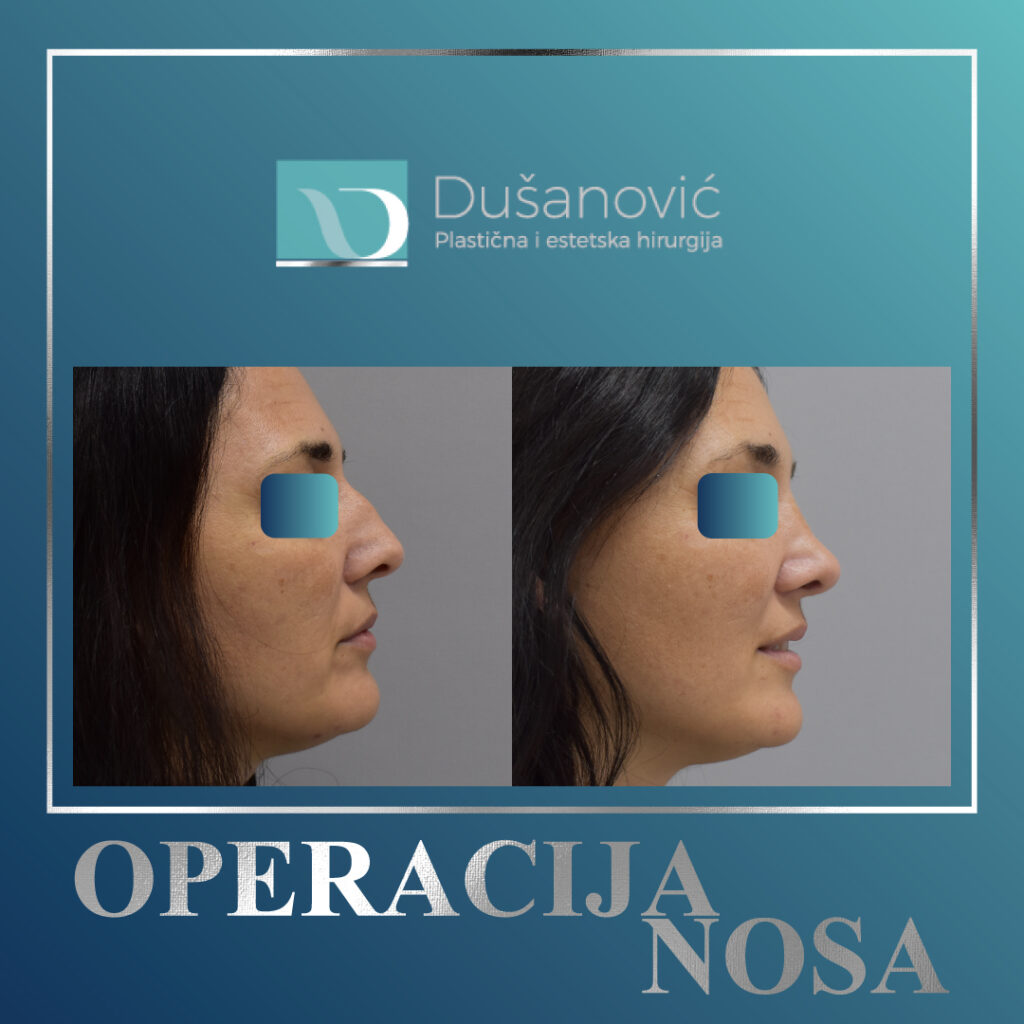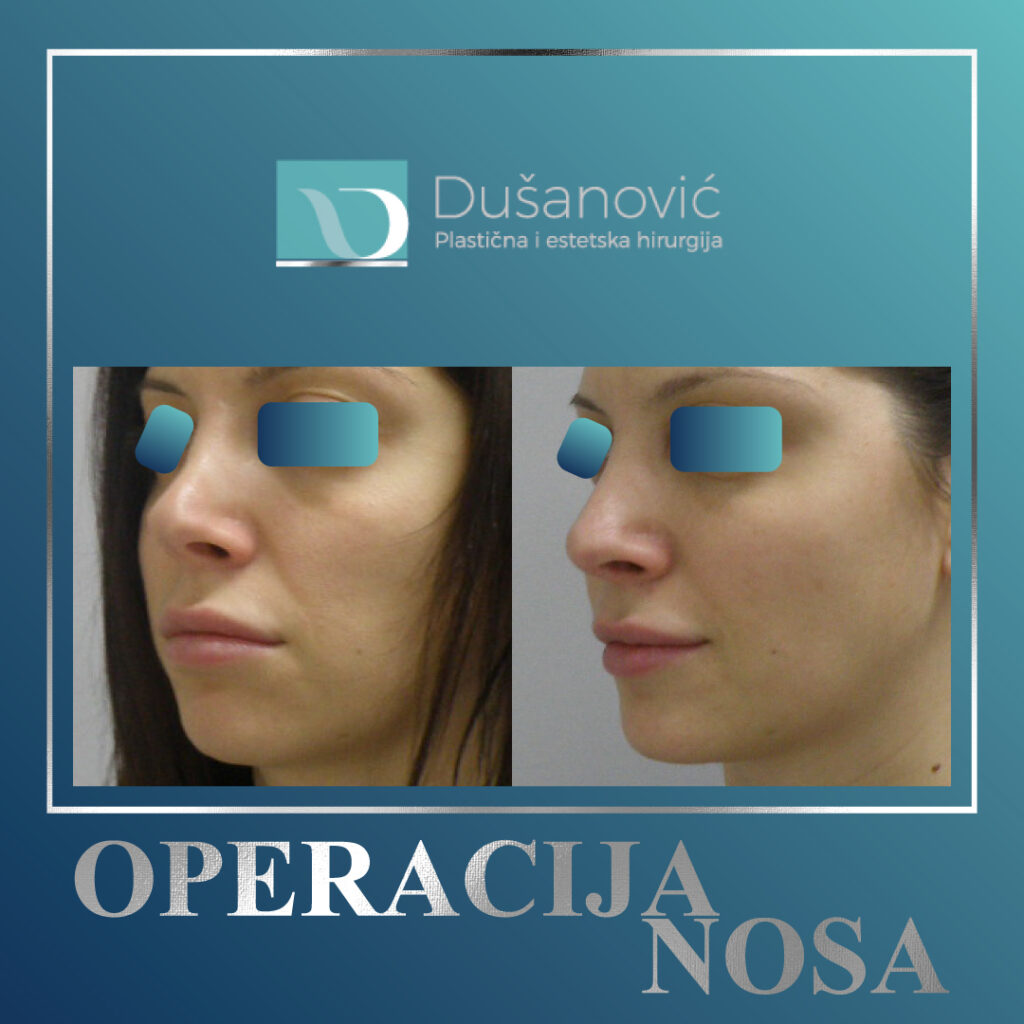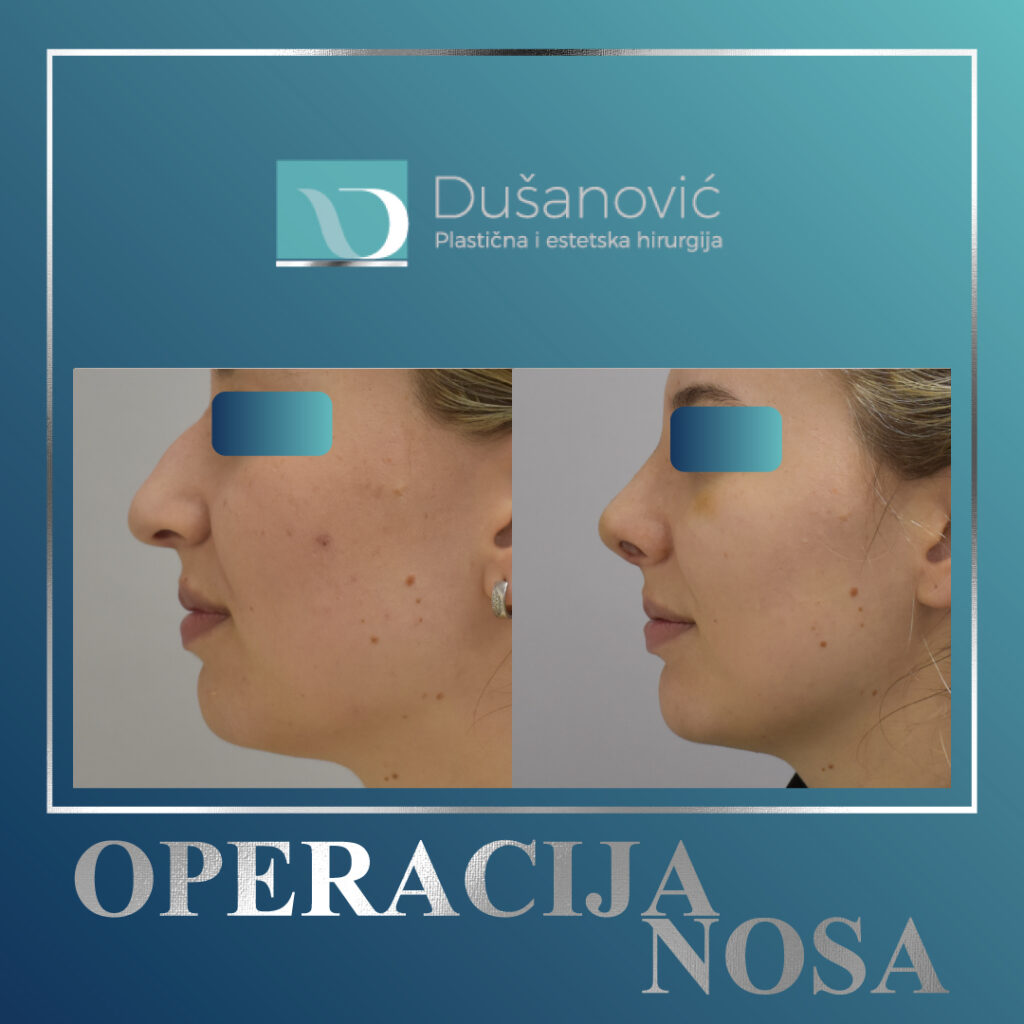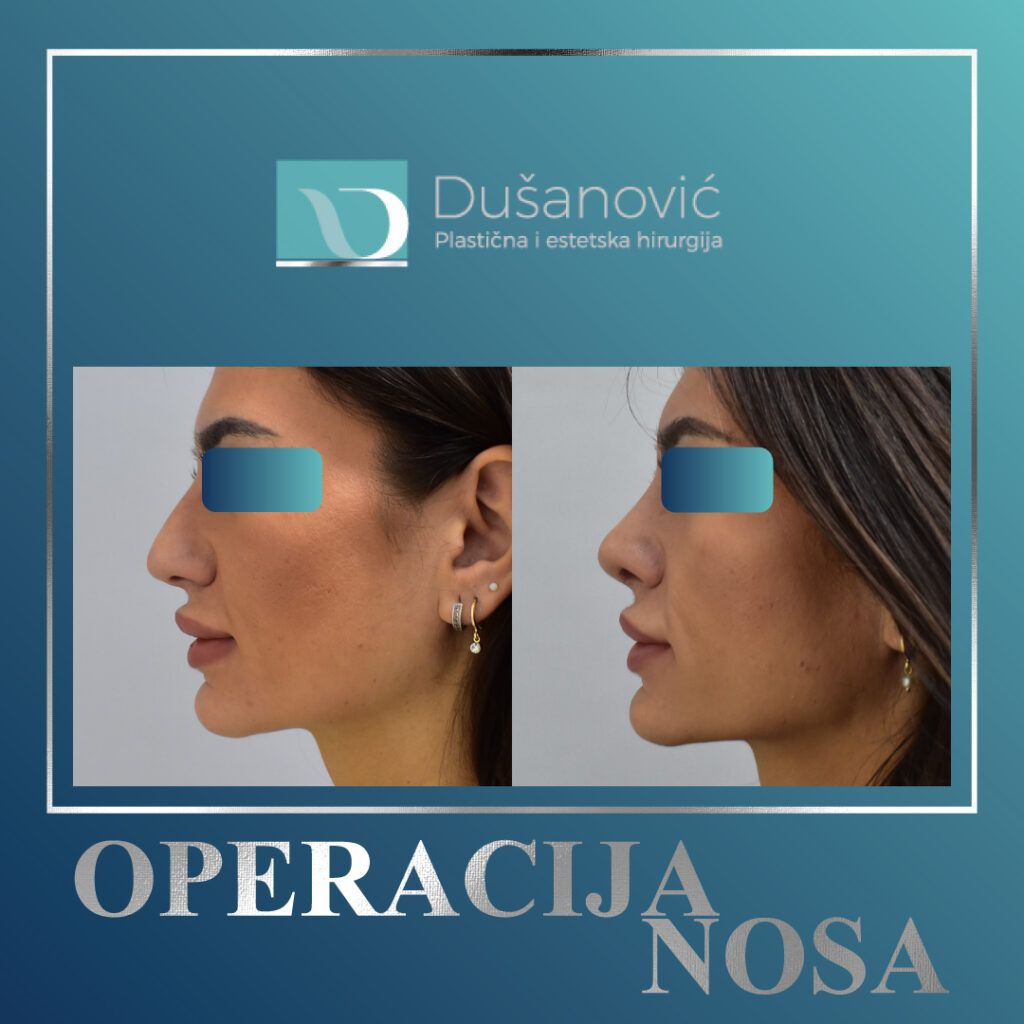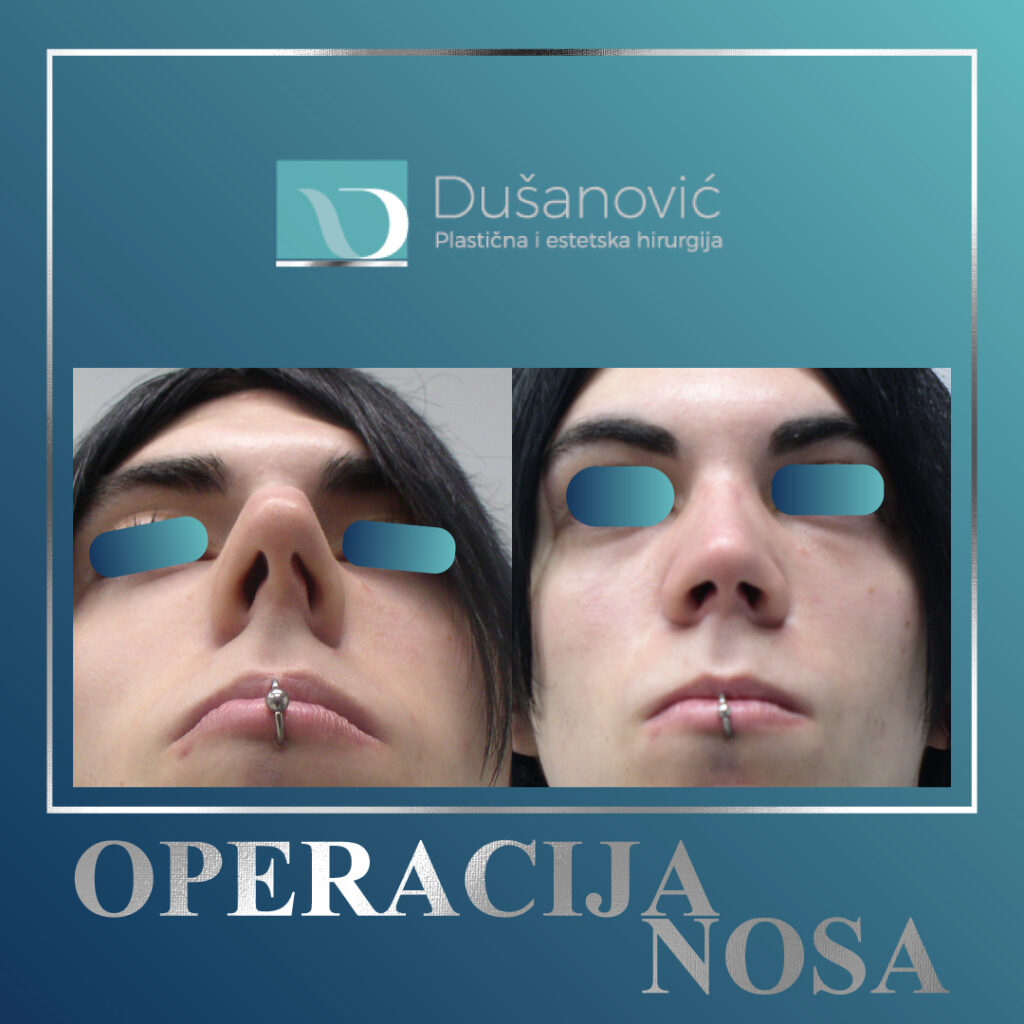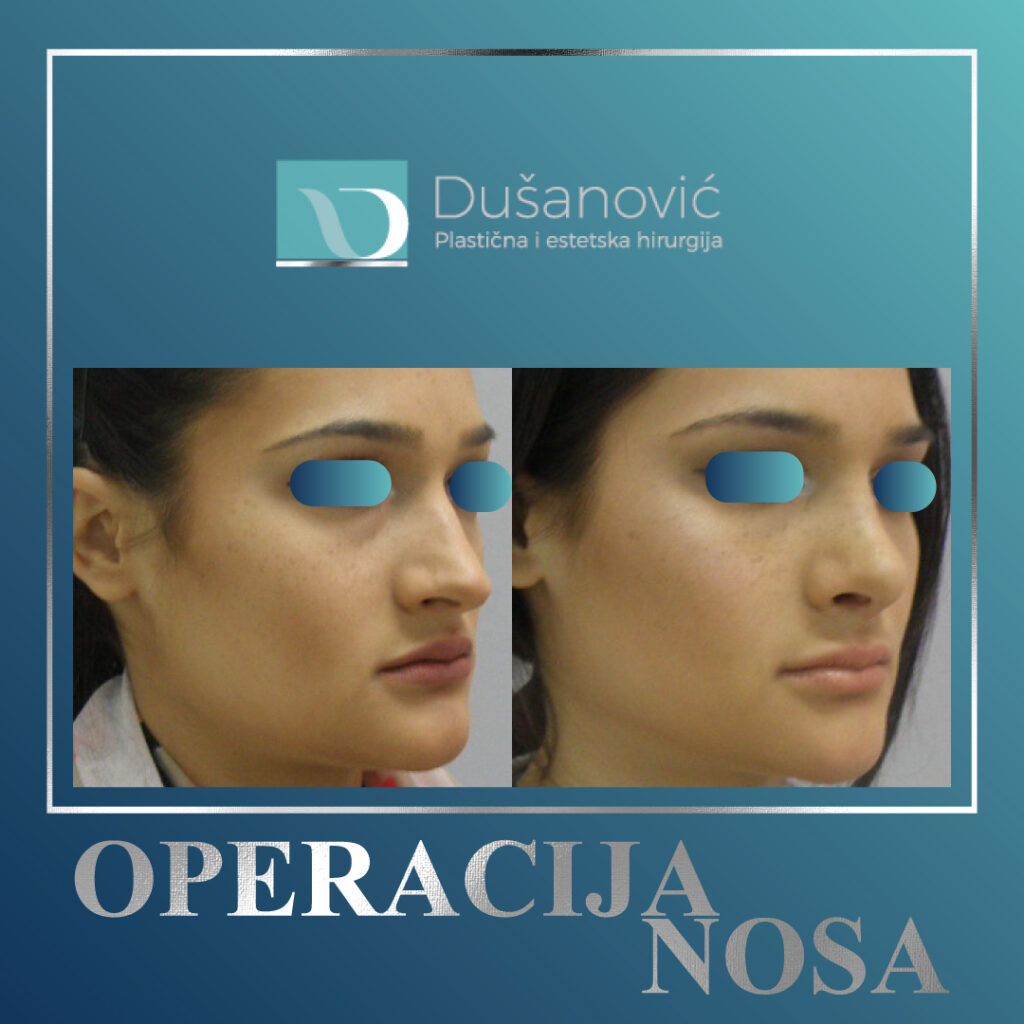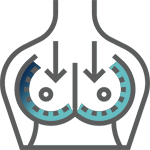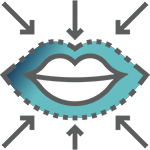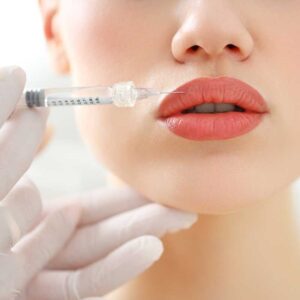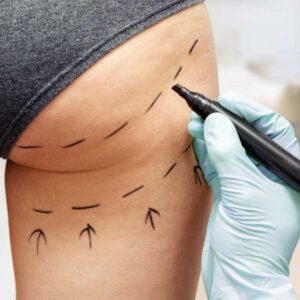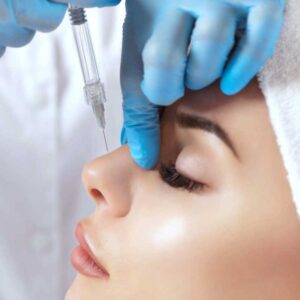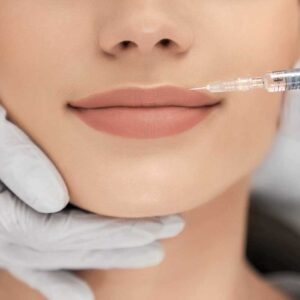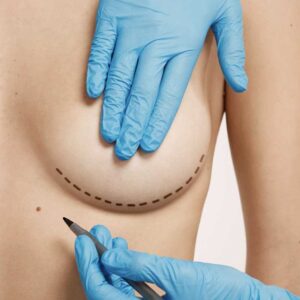- +381 11 761 4275; +381 63 827 2174
- Admirala Geprata 13, Belgrade, Serbia
Nose Surgery - rhinoplasty
Correction of the nose and nasal deviation
Primary Rhinoplasty – Corrective Rhinoplasty, Open Structural Rhinoplasty
Nose surgery, also known as rhinoplasty, is one of the most frequently performed aesthetic procedures in modern medicine. This procedure offers the possibility of improving the functionality of the nose, as well as the aesthetic appearance, adjusting it to the proportions of the face.
Regardless of whether you decide to undergo surgery for health or aesthetic reasons, the key factor for a successful result is careful planning and expert consultation with an experienced and trusted surgeon, such as Dr. Aleksandar Dušanović. Rhinoplasty will not only improve your appearance, the functionality of your nose, but it will also help you feel better in your own skin. Learn all about the process, recovery, and results of this procedure below.
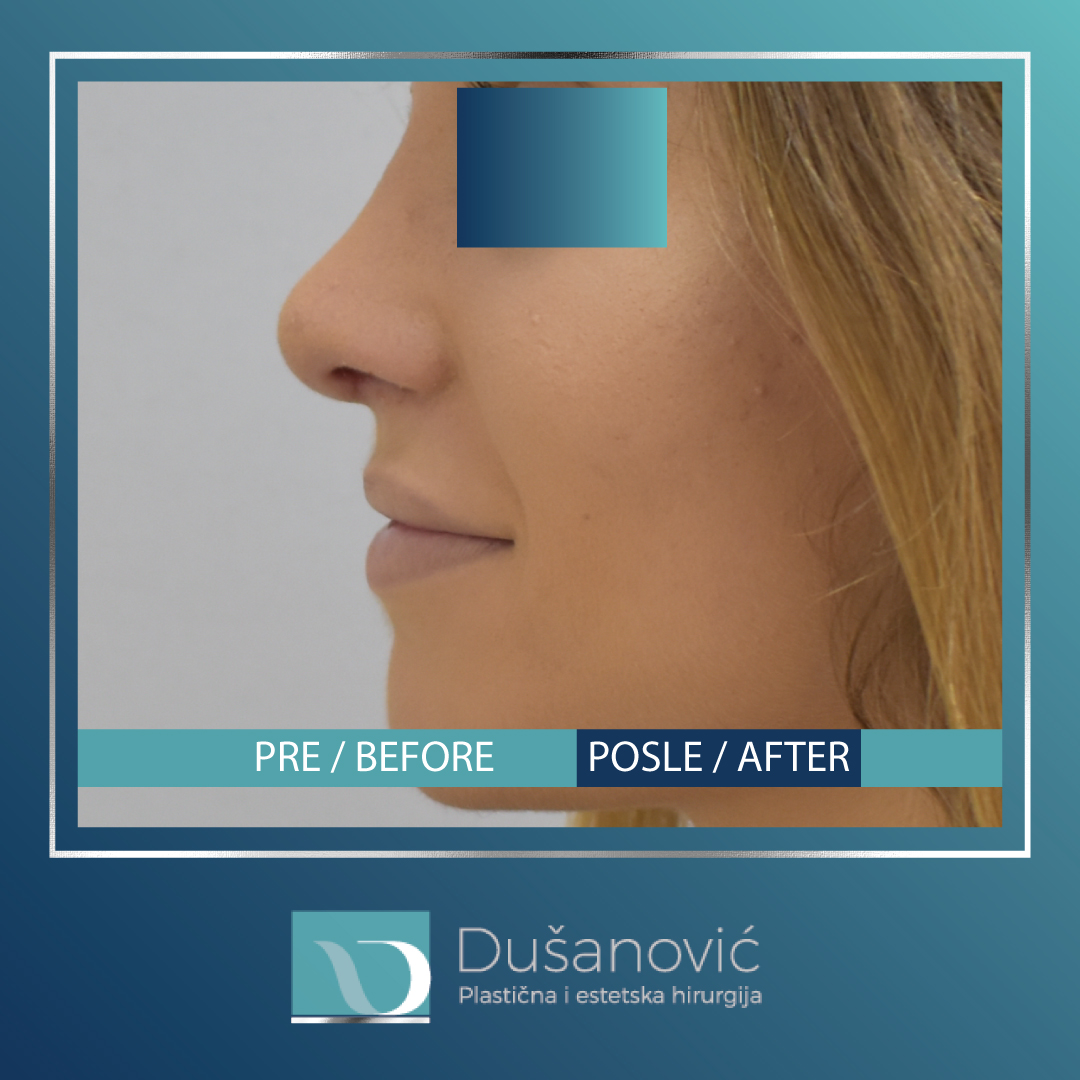
DETAILED CONSULTATIONS
PLAN
OPERATION
TENSIONING AND SHAPING
RECOVERY MONITORING
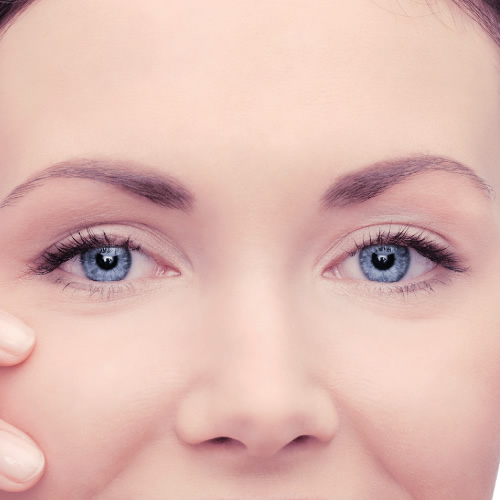
What is rhinoplasty and why is it performed and when?
Rhinoplasty, also known as nose surgery, is a surgical procedure that corrects the size and shape of the nose and solves the most common problems such as:
- Pronounced nasal ridge
- Too long, too wide (bumpy) nose
- Asymmetric top
- Crown nose tip
- Saddle nose
- Deformations of the nose after previous rhinoplasty or trauma
It is also possible to correct possible breathing disorders by correcting the nasal septum or removing excess nasal shells and mucous membrane, or correcting the nasal valve using spreader grafts, etc. with an open method (open approach).
Classic endonasal nose surgery is a long outdated technique that only aims to reduce parts of the nose without reconstructing them, which leads to numerous postoperative problems and cannot provide the patient with a postoperative degree of safety and all the necessary requirements of modern open or closed structural rhinoplasty.
Modern component structural rhinoplasty also implies the simultaneous correction of functional and aesthetic deficiency at the same time and bypasses the classic need to operate on the patient twice, once for aesthetic and the second time for functional deficiency.
“The roof of a house is not built on a crooked foundation”.
Although there is no age limit for rhinoplasty, adolescence is the moment when the nose practically reaches its full development. Only after reaching full physical maturity can surgical correction of the nose be recommended.
What does the process of preparing for surgery look like?
Preparation for rhinoplasty begins with a consultation with the surgeon, during which the condition of the nose is assessed, expectations are discussed and the goals of the operation are defined. The patient performs the necessary medical examinations, including blood tests and examination of the general health of the body.
Before surgery, it is advised to stop smoking and taking certain medications that can increase the risk of bleeding (anticoagulants). The surgeon also gives detailed instructions on nutrition and hydration before the procedure. Psychological preparation is an important part of the process so that the patient is ready for recovery with realistic expectations of results.

more
Nose operations are divided into aesthetic and functional. Aesthetic rhinoplasty focuses on changing the shape, size or proportions of the nose in order to improve the appearance and achieve harmony with the rest of the face. Functional rhinoplasty, on the other hand, aims to solve health problems, such as deviation of the nasal septum, difficulty breathing or the consequences of nasal injuries.
Often, aesthetic and functional procedures are combined, providing patients with not only better functionality, but also a satisfactory aesthetic result. Regardless of the type of surgery, an individual approach and expert assessment are the most important to achieve optimal results.

Course of nose surgery, operative technique and procedure duration
Nose surgery, i.e. rhinoplasty, is performed through incisions inside the nostrils, as well as a small, almost imperceptible incision on the underside of the nose, which allows adequate access to the nasal skeleton.
The open method provides numerous advantages compared to classic nose operations. The further procedure consists of changing the shape and position of the cartilages and bones of the nose in terms of reducing the nasal pyramid or increasing it. After the intervention, tampons are placed in the nasal passages, and a compressive mask is placed on the nose, which is removed after seven days.
The duration of the operation is 2 – 5 hours for primary interventions and is performed under general anesthesia. Possible, potential, small touch-up corrections can be performed under local anesthesia or IV sedation (a short-term type of anesthesia in which the patient is relaxed, drowsy or asleep and, of course, does not feel pain).
Recovery period: tips for a faster and safer recovery
Recovery after rhinoplasty requires patience and adherence to the doctor’s recommendations. Until the tampons are removed from the nose, the patient breathes freely through the mouth and is involved in normal life relatively quickly.
The recovery period after modern structural rhinoplasty is almost ten times faster, with minimal swelling and no pain, unlike classic nose surgery.
“The biggest risk for the patient is an inexperienced surgeon”.
Of course, there will be swelling around the eyes and surrounding tissue, and the final results are visible after a few months.
During recovery, you should avoid physical activities, wearing glasses and exposure to the sun. Hydration, a light diet and avoiding smoking speed healing. Regular check-ups with the surgeon help to monitor progress and prevent possible complications.
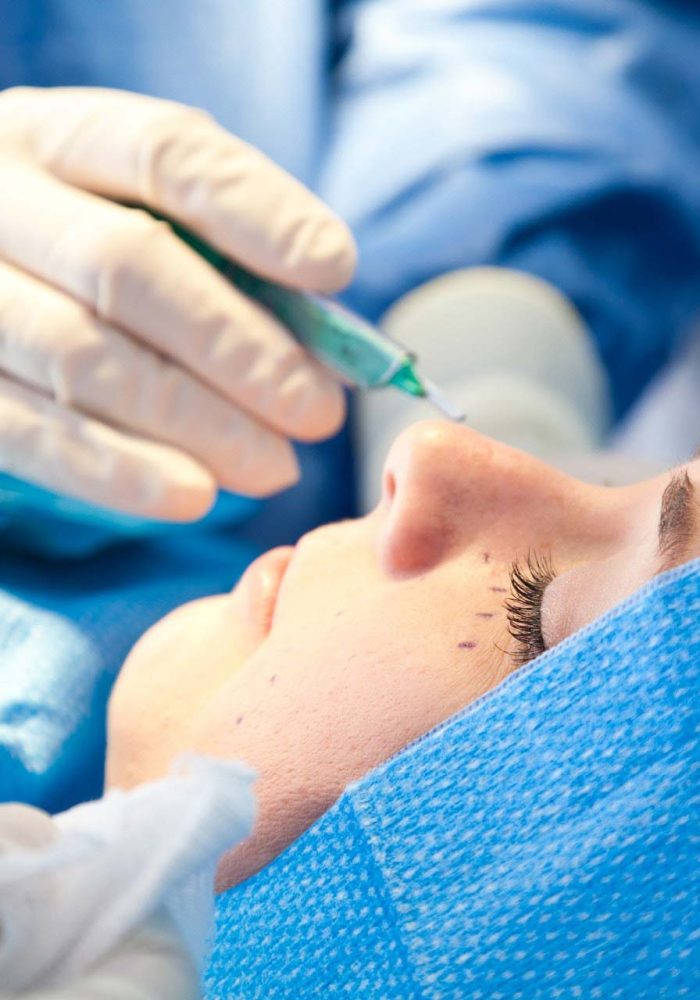
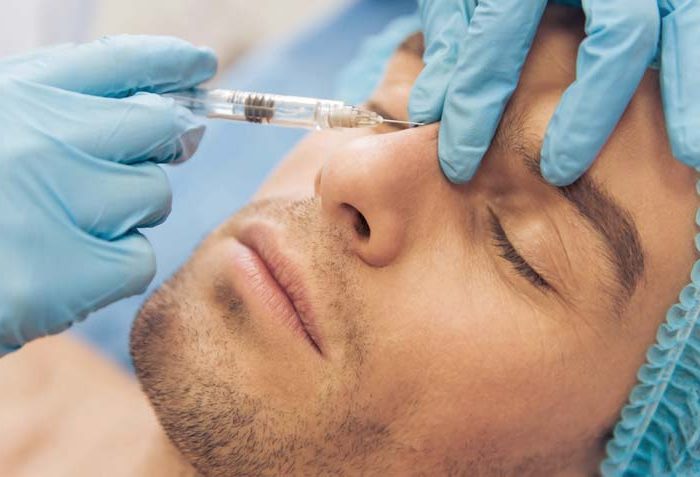
Possible risks and complications of nose surgery
Although rhinoplasty is a relatively safe procedure, as with any surgery, there are potential risks. These include infections, bleeding, scarring, reduced sensation in the nose or unsatisfactory aesthetic results. In rare cases, breathing problems or the need for additional procedures may occur.
Risks are reduced by choosing an experienced surgeon and following all recommendations during recovery. It is important that the patient is informed about all potential complications before making a decision about surgery.
Rhinoplasty results: what can you expect and what affects the price of the operation?
The results of rhinoplasty are visible gradually, as the swelling and bruising disappear over several months. The final appearance of the nose is usually formed between six months and a year after surgery when patients often show greater confidence due to a more harmonious facial appearance.
Functional changes, such as easier breathing, are noticed immediately after recovery.
The price of rhinoplasty varies depending on the complexity of the procedure, the experience of the surgeon and the location of the clinic. Aesthetic surgeries are usually not covered by health insurance, while functional ones, such as the correction of nasal septum deviation, can sometimes be partially financed.
Additional costs include examinations, anesthesia and post-operative care. And, since each case is a story for itself, it would be best to get accurate information about the price in a direct consultation with the doctor.

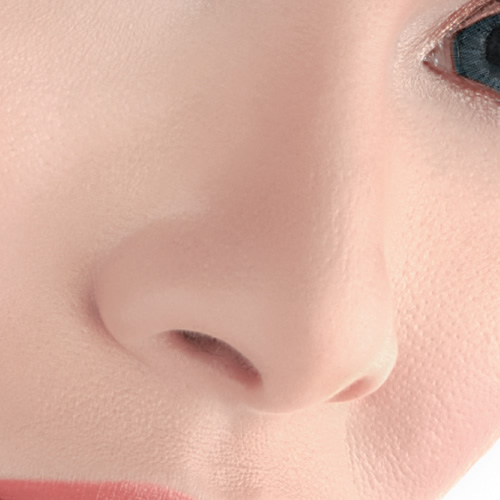
Secondary nose surgery
Secondary rhinoplasty or re-operation of the nose is carried out in order to correct the unsatisfactory results of the previous surgery or trauma to the nose. Rhinoplasty in the hands of an experienced surgeon and using adequate methods generally gives excellent results, however, in a small number of cases, the appearance of the nose after primary rhinoplasty can be improved by additional surgery. Reasons for secondary rhinoplasty are either an inadequate aesthetic result or breathing problems.
Goal: Establishing aesthetically desirable proportions of the nose, which were not achieved by previous surgery.
Operative technique: It mainly boils down to more modern techniques of the open method of nose reconstruction. It should be borne in mind that during the reconstruction of the nose, suitable natural material for reconstruction is necessary, which was mostly already used to a significant extent during the first operation. Sometimes it is necessary to take cartilage from the auricle or rib cartilage, in order to replace the deficiency. All this makes the re-operation of the nose more complex, which requires an experienced surgeon, who has previous experience in the field of secondary rhinoplasty.
Duration of the procedure and anesthesia: Depending on the complexity of the reconstruction itself, the operation can last from 2 to 4 hours and is performed under general or local anesthesia with iv analgosedation.
Recovery: As with primary rhinoplasty, the patient is placed with tampons, which are usually removed on the fourth postoperative day, as well as an immobilization mask, which is removed on the seventh day. It is definitely advised to refrain from heavy physical activities, in order to avoid the unnecessary formation of swelling and swelling. Swelling and welts on the face.
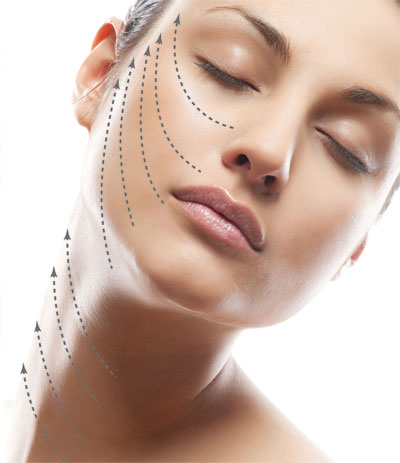
The highest standard of service provision
Patients choose Dr. Dušanović for his expertise, attention to detail and dedication to each patient. His individual approach enables the achievement of the desired results in a safe and pleasant environment.
But certainly one of the greatest advantages of working with Dr. Dušanović is his philosophy with a focus on the natural appearance and adequate function of the nose. Especially important is the extensive operational experience, especially in this area, gained in decades of work with the best in the world.
So, if you want a plastic surgeon you can trust, stop by his office in Belgrade and see why patients have nothing but praise for him.
Examples of performed procedures
Dušanović Plastic Surgery
Center for one-day plastic-aesthetic surgery
Contact
- +381 11 761 4275
- +381 63 827 2174
- aleksandar.dusanovic@gmail.com
- Admirala Geprata 13, 11000 Belgrade, Serbia
Location
- Copyright 2025 - Dušanović Surgery

